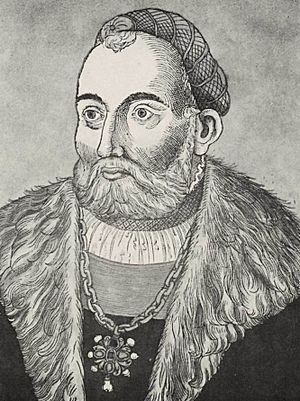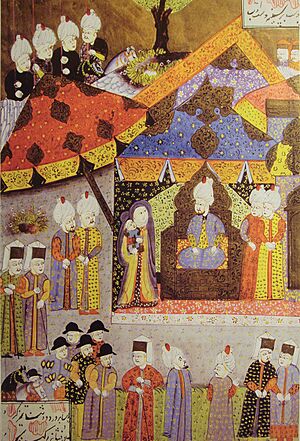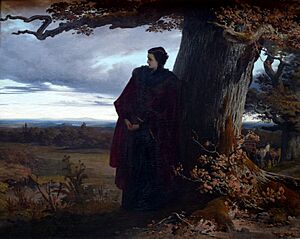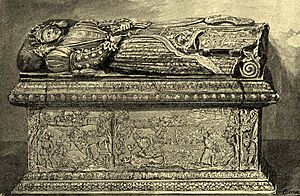Isabella Jagiellon facts for kids
Quick facts for kids Isabella Jagiellon |
|
|---|---|

Portrait by Lucas Cranach the Younger, 1553
|
|
| Queen consort of Hungary | |
| Tenure | 1539–1540 |
| Coronation | 23 February 1539 Székesfehérvár, Hungary |
| Born | 18 January 1519 Kraków, Poland |
| Died | 15 September 1559 (aged 40) Gyulafehérvár, Transylvania |
| Burial | St. Michael's Cathedral, Alba Iulia |
| Spouse | John Zápolya |
| Issue | John Sigismund Zápolya |
| Dynasty | Jagiellon |
| Father | Sigismund I the Old |
| Mother | Bona Sforza |
Isabella Jagiellon (born January 18, 1519 – died September 15, 1559) was a queen of Hungary. She was the oldest child of Sigismund I the Old, who was the King of Poland. Her mother was Bona Sforza from Italy.
In 1539, Isabella married John Zápolya, the King of Hungary. At that time, Hungary was a very disputed land. Different groups wanted control: Ferdinand of Austria, local Hungarian nobles, and the Ottoman Sultan Suleiman the Magnificent.
Isabella's marriage lasted only about a year and a half. But she gave birth to a son, John Sigismund Zápolya, just two weeks before her husband died in July 1540. After her husband's death, Isabella spent the rest of her life trying to secure the throne for her son. Sultan Suleiman helped her become the ruler (regent) of the eastern parts of Hungary. This area became a special place known for its freedom of religion.
However, Ferdinand of Austria still wanted to control Hungary. He worked with Bishop George Martinuzzi to force Isabella to give up her power in 1551. She went back to Poland to live with her family. But Sultan Suleiman was not happy about this. He threatened to invade Hungary. Because of this, the nobles invited Isabella back to Transylvania. She returned in October 1556 and ruled as her son's regent until she died in September 1559.
Contents
Isabella's Life Story
Early Life and Royal Plans
Isabella was born in Kraków, Poland, on January 18, 1519. She was the first child of King Sigismund I the Old and Queen Bona Sforza. Isabella grew up mostly at Wawel Castle in Kraków. She also spent time in the Grand Duchy of Lithuania.
Isabella received a very good education. She learned from a famous teacher named Johannes Honter. She could speak and write in four languages: Polish, Latin, German, and Italian.
When Isabella was just two months old, people started planning her marriage. French officials suggested she marry a future son of Francis I of France. Her mother, Bona Sforza, really wanted a French marriage. She hoped it would help Isabella gain control of the Duchy of Milan, which Bona believed was her family's rightful land.
Later, Bona tried to arrange an Italian marriage for Isabella. But these plans did not work out. Her father, King Sigismund, wanted a marriage with the powerful Habsburg family. However, their son Maximilian was much younger than Isabella, so that plan failed too.
Around 1531, a new idea came up: Isabella could marry John Zápolya, the King of Hungary. Hungary was divided at this time. One part supported the Habsburgs, and the other supported Zápolya. Zápolya was supported by the Ottoman Empire. Isabella's mother, Bona Sforza, was against the Habsburgs and wanted her husband to support Zápolya.
King Sigismund was careful. He did not want to upset the Habsburgs. He also doubted if Zápolya could keep his throne. Finally, Sigismund agreed, but only if Zápolya made peace with the Habsburgs. A peace treaty, called the Treaty of Nagyvárad, was signed in February 1538. This treaty said that Hungary would be divided. It also stated that Ferdinand would inherit Zápolya's land if Zápolya had no children.
Queen of Hungary
In April 1538, just two months after the peace treaty, plans for Isabella's wedding began. Many Polish nobles thought the marriage was a bad idea. But the wedding went ahead. On January 15, 1539, five hundred Hungarian knights arrived in Kraków. The engagement happened on January 26.
Isabella left for Hungary after the ceremony. Her dowry, which was like a gift of money and property, was very large. She traveled through Buda and met John Zápolya for the first time on February 22 in Székesfehérvár. He gave her several towns and castles. The next day, the wedding took place, and Isabella was crowned Queen of Hungary. The wedding celebration lasted a whole week in Buda.

Isabella was 20 years old, and her husband was 52. Their married life was short and not very happy. John Zápolya was often sick. In the spring of 1540, he went to stop a rebellion in Transylvania. Isabella stayed in Buda because she was pregnant. Their son, John Sigismund Zápolya, was born on July 7, 1540. John Zápolya died just two weeks later, on July 22.
Isabella's Time as Regent
The Treaty of Nagyvárad said that Ferdinand should become king after John Zápolya died. But Hungarian nobles, especially Bishop George Martinuzzi, did not agree. In September 1540, they chose Isabella's baby son, John Sigismund, as King of Hungary. Isabella became his regent, which means she ruled for him while he was a child.
Ferdinand then invaded Hungary and attacked Buda, where Isabella and her son were. The city survived two attacks. The second attack in May 1541 was stopped by Suleiman the Magnificent, the Sultan of the Ottoman Empire. Isabella did not get help from her own father.
Suleiman decided to take most of Hungary for himself. He left Transylvania and some other lands to John Sigismund and Isabella. These areas became a vassal state, meaning they were under the Ottoman Empire's protection.

In September 1541, Isabella left Buda. She moved to Gyulafehérvár. She found her new lands in poor condition and had money problems. Isabella was young and known for her beauty. She also liked expensive things. Three pieces of her jewelry still exist today: a diamond ring, a pendant with opals, and a gold necklace.
She started rebuilding the old bishop's palace in Alba Iulia. She wanted it to look like the beautiful Wawel Castle in Poland. Isabella faced many challenges. She had to keep peace with the Ottomans, manage Martinuzzi's power, and stop Ferdinand from taking Transylvania.
In 1548, Ferdinand and Martinuzzi started talking about uniting Hungary. Isabella would give up Transylvania. In return, she would get lands in Silesia and money. John Sigismund would also marry one of Ferdinand's daughters. Isabella fought for her rights and even used her army. But her brother, King Sigismund II Augustus, did not help her.
Back to Poland
In the fall of 1550, Isabella's troops had to agree to a truce. She was surrounded in Buda. In July 1551, Isabella surrendered and signed the Treaty of Weissenburg. She agreed to give up Transylvania. In exchange, she would receive lands and money. John Sigismund was also promised to marry Ferdinand's daughter.
In August, Isabella gave up the Holy Crown of Hungary. Legend says that the cross on top of the crown broke off. John Sigismund kept it, hoping to put the pieces back together one day.
In September 1551, Isabella left Transylvania. A story says that she carved her motto, "SFV" (Sic fata volunt – "It is the will of fate"), into an oak tree. This motto was also on her jewelry and coins.
She arrived in Opole in March 1551. She found the place ruined. The buildings were not fit to live in, and the money she was promised was only half of what she expected. Ferdinand was also slow to pay her. After only a month, she left Opole and went to Poland. She lived with her family for the next five years. Her brother gave her some lands to help her financially.
Return to Transylvania
Things in Hungary were still not peaceful. George Martinuzzi was killed in December 1551. The Ottomans captured some areas and attacked others. Sultan Suleiman the Magnificent and local nobles invited Isabella to return to Hungary. She waited for the right moment.
Her brother, King Sigismund II Augustus, married Catherine of Austria, Ferdinand's daughter. Isabella and her mother demanded that Ferdinand keep his promises from the Treaty of Weissenburg. But Ferdinand did not have the money. Isabella decided that since he did not keep his part of the deal, she was free to return to Hungary.
In February 1556, Isabella and her mother, Bona, left Warsaw. Isabella spent the summer in Lwów, waiting for a good time to go back. With Ottoman soldiers, she entered Kolozsvár in October. On November 25, 1556, the Transylvanian Diet (a meeting of nobles) gave her power to rule for her 16-year-old son for five years.
Isabella started her own government in Transylvania. She even made her own gold coins. These coins showed the Madonna and Child on one side. On the other side, they showed a mix of family symbols: a wolf and unicorn for the Zápolya family, an eagle for Poland, a snake for the Sforza family, and three panther heads for Dalmatia.
In 1557, Isabella made an important rule. She signed an edict that gave freedom of religion to four different Christian groups: Catholics, Lutherans, Calvinists, and Unitarians. This was a very important step towards religious tolerance and happened before the famous Edict of Torda of 1568. Isabella is known as one of the first European rulers to create laws about religious freedom.
Isabella died after a long illness in September 1559. She had been back in Transylvania for only three years.
Images for kids
-
Portrait by Lucas Cranach the Younger, 1553
-
Portrait of John Zápolya
-
Suleiman receives Isabella and her infant son John Sigismund in 1541










